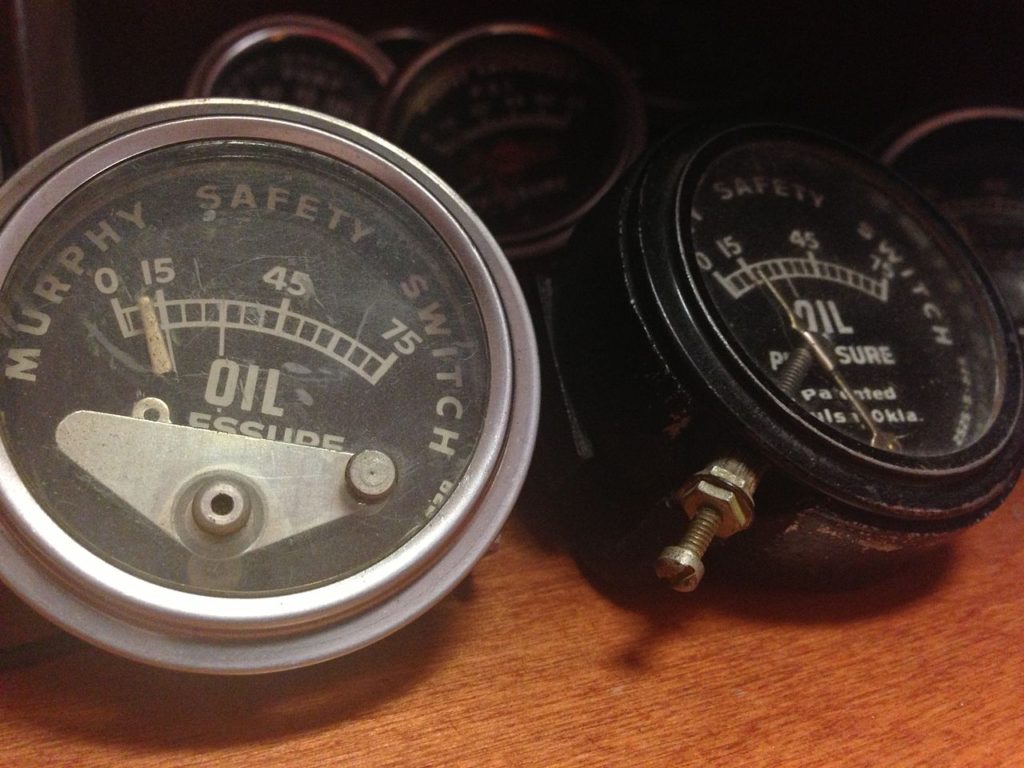My dad has a new mini-van. He has never owned a mini-van before but his old car was starting to get unreliable and this vehicle had features his wife and youngest son thought were necessary. This van’s dashboard is a modern technology fun fest with multi-color LED screens reflecting menus and sub-menus associated with each button. Pretty fancy unless you just want to know the engine temperature and oil pressure. You see, my dad was taught to drive in an era when service station attendants lifted the hood and checked the oil while they pumped the gas. This was normal and required service. As hard as it is to believe now, there was time when even new engines leaked or burned some oil and any car with more than a few miles on it would require the oil or other fluids to be topped off periodically. For my dad, and the children he taught to drive, immediate access to oil pressure and coolant temperature information is necessary.

When I was taught to drive tractors on the farm I was instructed to monitor the gauges while working and to stop what I was doing if the gauges indicated trouble. This skill set of monitoring my task and my equipment was instilled in me at a young age. Raking hay, or plowing or cultivating for long hours required constant attention to the equipment, the immediate terrain and the feedback given by the engine sound and gauges. A lapse in attention was immediately evident – no need to go into those stories here.
My son Ben gave me a new-fangled way to monitor my truck engine. A doohickey plugs into the place thing, and then I touch a colored tooth on my cell phone (is any of this making any sense?) and then I open an app and I see: oil pressure, RPMs, voltage, coolant temp, cam shaft angle, torque, horsepower, gas mileage, and any error codes. There should be probably be an error code for: Warning Old Guy Using New Technology.
We hear a lot about “dashboard indicators” in the education and business world. At a glance we should, in theory, be able to tell where we are in any desired process. In my way of thinking about it a dashboard is one way to see if I’m really living intentionally. This is not a new idea. Just about every chapter in Proverbs has a verse that urges us to pay attention, remember what is important and stay focused.
Wayne Cordeiro, in his book Leading On Empty,1 suggests that you and I need a personal dashboard that we monitor in order to live intentionally and avoid burnout. Recently I noted that we tend to be reactive to our world or follow the path of least resistance or popularity and then get frustrated when we don’t end up with the result we had envisioned. For Cordeiro, a pastor, writer and speaker, his dashboard has the following: Faith Life; Marriage Life; Family Life; Office Life; Computer Life; Ministry Life (work); Financial Life; Social Life; Attitudinal Life; Author’s Life (work); Speaker’s Life (work) and Physical Life. Like my dad watching the plow, the furrow and the engine gauges Cordeiro makes it a habit to keep an eye on his gauges. Some gauges he watches personally. Some gauges he monitors with a friend, or spouse. My friend, Roger, reminds me from time to time of the Covenant question “how goes your walk?” that should be spoken among trusted friends. Some gauges are rough measures (for example, open dates on a calendar indicating possible relaxation). Some gauges have commas and decimal points (for example, a financial spreadsheet indicating attention to detail and a possible positive bank balance). The key here is to know your gauges and pay attention to them so you can be intentional in your living.
Cordeiro lists twelve gauges but you certainly will have different ones and probably fewer. There is an old psychological principle of memory and attention that humans are pretty good at recalling a certain number of digits: seven, plus or minus two. In all my years of counseling I have found that number works for other things too. We can keep track of about seven people, projects or deadlines (plus or minus two) and do well. Add too many and we start to miss things. Drop our tasks too low and we get bored. Seven, plus or minus two, seems like a pretty good rule of thumb for things on your dashboard.
Finally, there is the issue of what you want the gauges should tell you. Cordeiro uses an academic scale with shaded grading (A+ to F) on his twelve dash board. You could use colors or a numeric scale from minus 100 to positive 100 (I use that one on teaching evaluations). The gauges could look the same but some of you are pretty creative! Maybe a frowny face to a happy face? Or for the adventurous you could use the Scoville scale and rate your intentionality by chili peppers! The key is to have a dashboard and look at it from time to time.

There is a company that keeps asking me what is in my wallet as if that was a good dash board indicator. I think a better set of questions for me is what is my oil pressure? How does the engine sound? What is on ground just ahead of me? What is on your dash board?
In Christ,
Phil
- Thanks to Dick, another friend, for lending me the book on leadership. The book became a great blessing at just the right time.↩


